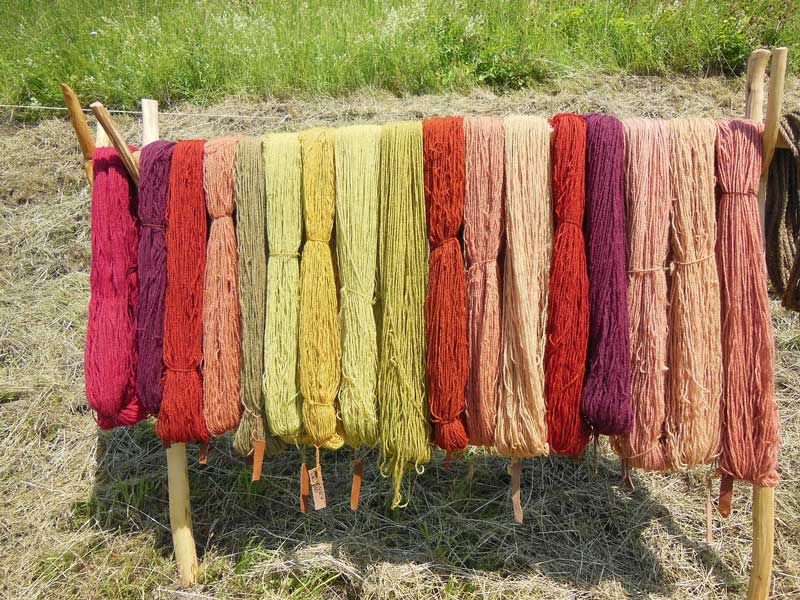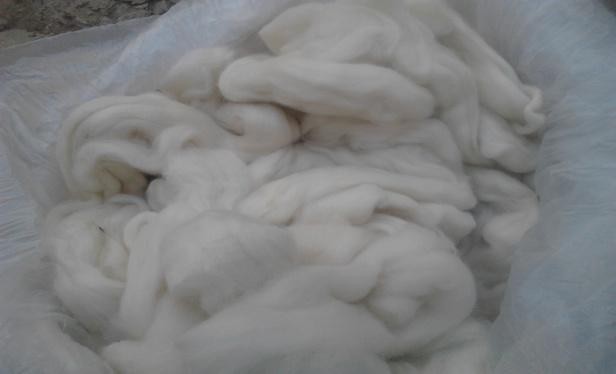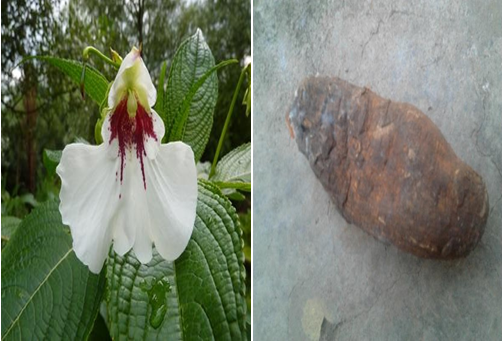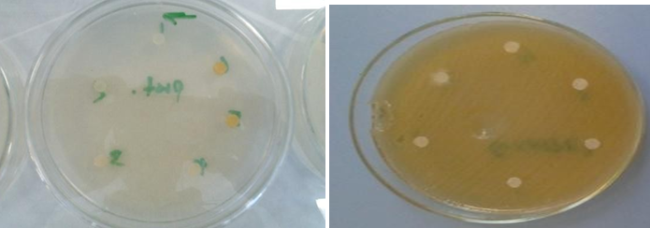
Wool fibre dyeing with natural dyes
The application of natural dyes on wool has good fastness properties and good substantivity, informs Minyahil Terefe.
Natural dyes are colouring matters obtained from naturally existing sources. The word “natural dye” covers all the dyes derived from the natural sources like plants, animals and minerals. Natural dyes are mostly non-substantive and must be applied on textiles by the help of mordants, usually a metallic salt, having an affinity for both the colouring matter and the fibre.
Introduction
Use of natural dyes in dyeing of textile materials and other purpose is just one of the consequences of increased environmental awareness. Natural dyes exhibit better biodegradability and generally have a better compatibility with the environment. Also, they possess lower toxicity and allergic reactions than synthetic dyes.
Extraction of natural dyes is known to be challenging task. So as to get the maximum dye extract alternative extraction systems as well as modern extracting equipment need to be used. On the application of the dye extract on to the textile substrate through investigation on the fibre dye interaction is demanded for it determines the dye uptake and fastness property of the dye. The previously done investigations on this plant extract is indicative of the poor fastness of the dye on cotton fibres and better fastness on the silk fibre but the depth of shade was very light on both substrates used. The alkaline industrial soap used for washing highly affected the wash fastness. Considering the main challenges and limitations faced by the previous research work, this research work emphasizes on investigating all possibilities that increase concentration and purity of the dye extract, increase the depth and brightness of the shade on wool fibre taking advantage the presence of low molecular weight colour components like anthocynins, lawsone and naphtoquinone which are expected to be found in the dye extract. The research also investigates the potential of the plant extract to be used as antimicrobial agents which is the advantage of using natural products as a result of their nontoxic and non-carcinogenic nature, that rarely happen in synthetic dyes.

Natural dyes
Natural dyes of plant, mineral and animal sources are fascinating, beautiful and sometimes they challenge the wits of researchers and educators. Colouring matter extracted from the roots, stems, leaves or berries, and flowers of various plants have various exceptions and are also not substantive (have little or no colouring power by themselves) except when used in conjunction with mordants. Lack of colour fastness resulted in the discovery of mordants substances which aid in the absorption of dyes. There are vast number of plants whose extracts can be used for the dyeing of wool, silk, cotton and linen; there are also a few examples of dyes of animal origin. Different parts are used depending on the plant, whether the whole plant, the bark, the heartwood, the leaves, the roots or the fruit. For various reasons, e.g. due to the dyeing behaviour, the fastness or the biological availability, only some of the extract of have gained widespread acceptance as dyes. As natural dyes are obtained from different sources which vary with source, location temperature, altitude and maturity period etc so, it is difficult to reproduce shades by using natural dyes/colorants.
Materials and methods

Wool fibre (worsted) was collected from a factory in Addis Ababa Ethiopia. The fibre was scoured and where of white in colour as shown in Figure 1.
Natural dye was obtained from plant which is fully grown Ensosilla plant root (Impatiens Tinctoria) is collected from Bahir Dar city market in Amahara region, Ethiopia. (Figure 2)
The natural dye was extracted from the plant material by using solvents like Ethanol, acetone, chloroform and methanol with analytical grade of (Optima Liquid Chromatography/Mass Spectroscopy, Formulated for Ultra High-Pressure Liquid Chromatography –Ultra Violet 99.9 per cent min GC for acetone and 99.5 per cent min GC for ethanol, methanol and chloroform) are used. Organic solvents are most commonly used for organic colorants extraction from plants. The mordants are chosen based on the research done on the plant dye previously. All were brightening mordants. Mordents improve the fixation and fastness properties of dyes lacking substantively for natural fibres. The other auxiliary chemicals acetic acid and sodium carbonate is required for maintaining the appropriate pH. The selected wool fibres were dyed with natural dyes and evaluated for their light and wash fastness, anti-microbial efficacy, FTIR spectroscopy and colour strength values using standard calibrated testing equipments.
Experimental procedure
The experimental procedure conducted for natural dyeing method on wool fibre is shown below. The Process flow chart of dye extraction, dyeing, and quality evaluation is shown below.
⦁ Preparation of the dye powder
Known quantity of plant root material is washed well to remove the soil from the root and then scrubbed, smashed, chopped and then dried in an oven dry at 60 degC. After drying the plant root material is grinded in a coffee crusher to fine size like that of coffee used by drip coffee makers (cone filters) to get the powder material which is ready for extraction.

⦁ Dye extraction
For solvent extraction 1 gm of powder material is mixed in 50 ml of the four organic solvents (ethanol, methanol, acetone and chloroform). The solutions were stored for 24 hours. The Aqueous extraction was done using 30 gm of wet fresh material mixed in 600 ml water at different pH conditions (4, 7 and 9.5) and boiled for 45 min. Among the four organic solvents the best solvent for extraction was chosen based on the UV- Vis absorption value of the dye extract. The 24-hour stored solution was filtered, diluted and checked for UV- VIS absorption value and the solvent with higher absorption peak was chosen for soxhlet extraction. The best pH condition in aqueous extraction was checked by the same technique.
⦁ Optimisation of dyeing parameters
Worsted wool fibre was soaked in cold water for ten minutes before exhaust dyeing. Exhaust dyeing method was followed in eco-infrared dyeing machine. The dye is prepared in the form of stock solution with concentration of 8.42 per cent (mixing 16.84 grams of extracted dye in 200 ml water). The dyeing was done by varying the dyeing variables MLR, time, temperature and dye concentration. MLR was varied from 1:20 to 1:60 with 1:10 interval. Dyeing was done at 90 o c for 60 min. The colour strength of the dyed wool fibre is measured and MLR which resulted in high K/S value was chosen as optimum. Dyeing was done at 90 o c with varying time from 20 min to 60 min. The colour strength (K/S) of the dyed samples was measured using Gretag Macbeth spectrophotometer colour eye 3100.
The optimum time obtained from the dyeing time optimization was taken for the dyeing temperature optimization. For optimization of temperature three levels were considered that were 60, 80 and 90 deg C. Taking all the optimum values obtained in the previous experiments six different dye concentration values (2.5 per cent, 5 per cent, 7.5 per cent, 10 per cent, 12.5 per cent and 15 per cent) were considered to check the effect of dye concentration on the colour strength (K/S values).
Results and discussions
The dyed wool fibre samples were evaluated for its performance by conducting various objective
evaluation tests.
⦁ Fastness properties
The fastness of wool fibre dyed with the presence of mordant and without mordant has been checked for light and wash fastness on Mesdan CE (model: Auto wash) wash fastness tester. The fastness for light was conducted on Mesdan S.P.a. Italy light fastness tester (model: solar box). Highest Wash fastness achieved for stannous chloride (5-color change and 5 –colour stain) was at 10 per cent concentration in post mordanting system and it was comparably better than the fastness of non-mordanted wool fibre (4/5-color change, 4/5 colour stain). Wash fastness of potassium dichromate mordanted wool fibre was lower than that of the non-mordanted samples (4/5-Color change and 4/5-color stain). The wash fastness of Aluminium sulphate mordanted sample is better than non-mordanted wool in all the mordanting systems and the concentrations of the mordant considered.
⦁ Antimicrobial potential testing
The test results on the antimicrobial testing of the plant extract for both aqueous and solvent extracted dye was not a pass. The potency of the dye components in the plant extract was not able to prevent the growth of the four bacterial strains. As it can be seen in the Figure 3, the zone of inhibition is visible for the Cromaphenicol antibiotic, but in contrary there is no zone of inhibition for the paper disks soaked with the plant extract (Figure 3).
Caption for the image: Figure 3: Bacterial inoculated agar with dye extract-soaked filter paper before and after incubation with no zonal inhibition
⦁ FTIR spectroscopic analysis
Spectroscopic IR transilluminating technique is used for qualitative studies of changes in the overall structure of fibres. Qualitative analysis of the absorption spectra makes it possible to assess transformations of chemical groups and macromolecules as a result of interactions with external factors. The changes in molecular structure manifest themselves by appearance of new absorption bands correlated with the newly formed chemical groups, or by changes in intensity of the absorption bands correlated with the existing chemical groups. The relative absorption on FTIR indicates that dyed wool has relatively same absorption peaks with no shift of wave length as undyed wool fiber (figure 4). As can be seen the effect of the dye used on the wool dyeing was insignificant as there was no significant shift of wave length or intensity of the peak. In the case of dyed wool the number of acid and base groups were not changed because the number of -NH-CO- groups indicated no shift of wave band at 1628 cm-1. The C=O stretch of the functional groups of carboxylic acids has shown a shift of wave number from 1742.66 to 1750.42 but this shift is not significant shift to signify existence of new functional group. So, from this also it can be knotted that there is increase in the amine and carboxylic acid groups which in turn result in the formation of peptide linkage but the effect of newly formed bonds is insignificant to result in significant shift of wave length.
0.035
0.030
0.025
0.020
0.015
0.010
0.005
0.000
500 1000 1500 2000 2500
wave number (cm-1)
Figure 4: FTIR absoption spectrum of dyed and undyed wool
The FTIR spectrum result of dye extract is shown on Figure 5. The peak at wave number (1715 to 1760) was due to the presence of (-C=O stretch). During dyeing this stretch involve in hydrogen bonding keeping the stretch with increased intensity from undyed wool to dyed wool. Like (-C=O) stretch the C-N stretch was shown on both the un- dyed and dyed wool but this stretch hadn’t shown shift of wave number.
0.010
0.009
0.008
0.007
0.006
0.005
0.004
0.003
0.002
500 1000 1500 2000 2500
wave length (cm1)
Figure 5: FTIR spectrum of ethanol extracted dye
Conclusions
In the present scenario, sustainability is the talk in the textile arena and most of the countries procuring textiles are focusing on this concept. Hence, most of the natural dyers are interested to use natural dye materials in the same way used for synthetic dyes. A research work has been carried out on use of natural dyes on protein fibres like wool. The application of natural dyes on wool has good fastness properties and good substantivity. From the comparative UV/ Visible analysis of solvent extracts and other research outcomes on different plant species ethanol was the best organic solvent for dye extraction from the plant. The observed absorption on UV-Vis spectroscopy and characterization with FTIR spectroscopy under selected wavelength indicated that the colour components have functional groups and chromopheres responsible for reaction and colour. Therefore extraction of natural dyes from Impatiens Tinctoria and dyeing of wool fibre irrespective of its positive effect on colour strength.
References
- Ashis K. and Adwaita K, (2011), Dyeing of Textiles with Natural Dyes, Natural Dyes, Dr.Emriye Akcakoca Kumbasar (Ed.), ISBN: 978-953-307-783- InTech.Availablefrom. ⦁ http://www.intechopen.com/books/natural-dyes/dyeing-of- ⦁ textiles-with-natural-dyes.
- Bag G.C and Lemino S, (2013), Phytochemical Analysis And Determination Of Total Phenolics Content In Water Extracts Of Three Species Of Hedychium, International Journal of Pharm Tech Research ,5(4) p-1518-1519.
- Balankina G G, Vasiliev V G, Karpova E V and V I Mamatyuk, (2011), Titrimetric and Polar graphic Determination of Carminic Acid and its Quantification in Cochineal (Dactylopius coccus) Extracts Dyes Pigments, 7154.
- Kumar V & Bharti B V , (1998) Indian Text J, (2) 18
- www. Anabolicminds .com(February ,2014).
About the author:
Minyahil Terefe is a Post Graduate in Textile Chemistry from Ethiopian institute of textile and Fashion Technology. He has around 10 years of experience in textile industry in Finishing department in Textile Wet Processing in leading textile industries in Ethiopia. He has been associated with Textile and Garment Research and Development Centre (TGIRDC) as Directorate and desk coordinator for the past 10 years.




